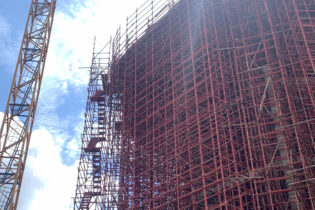The Ingula Pumped Storage Scheme Project in the Drakensburg reached some significant milestones in 2012. With a design set to contribute to South Africa’s power demand in a way that will enhance maximum power generation efficiency, the Eskom project is in line with meeting government’s sustainability commitments.
Work on the project commenced in 2004 and will be completed in 2015. According to Andrew Wilson, technical executive for Dams, Hydropower and Underground Works at GIBB, the team, which is a joint venture between GIBB, Royal HaskoningDHV and Knight Piésold, has made significant strides on the project. “The site was chosen after being identified in previous studies as the optimal location for a large pumped storage scheme, based on technical, environmental and social criteria,” says Wilson. “It takes advantage of the significant difference in elevation between the inland, Highveld region and the bottom of the escarpment.” The project which includes the 40m high RCC Braamhoek Dam and 50m high CFRD Bedford Dam, both completed in 2011, two caverns, four surge tanks, four drainage and ventilation shafts and over 14 km of tunnels is the largest hydropower and tunneling project under construction in Southern Africa. The excavation work that comprised approximately 2,20 million m3 of surface and underground excavation commenced in September 2008 and is substantially complete with only two surge tanks remaining.In January, the excavation of the machine hall was completed followed by the completion of the concrete encasement of the first draft tube in August 2012. The preparation for the installation of the first spiral case installation is ongoing and the spiral case was transported to the erection bay on 15 August and is being prepared for installation.
One of the greatest difficulties that was faced by the project team was overcoming the steep gradient of the two 6.1m excavated diameter headrace tunnels that are both 1 940m long and each with a 970m long section at an inclination of 1:2.2. Tracked machinery was required for all excavation phases but the long average time for the mucking contributed to a final advance of only 1.1 m/day. Installation of the 5.1m diameter steel lining of these tunnels has now started. The contractor plans to place the concrete encasement of the lining by pump from the bottom of the tunnels and it remains to be seen if this will be successful. “We are very proud and happy to be part of the largest hydropower and tunneling project in the region. This further highlights the trust that the industry has in GIBB and the caliber of work we continue to produce on every project that we embark on,” adds Wilson.







